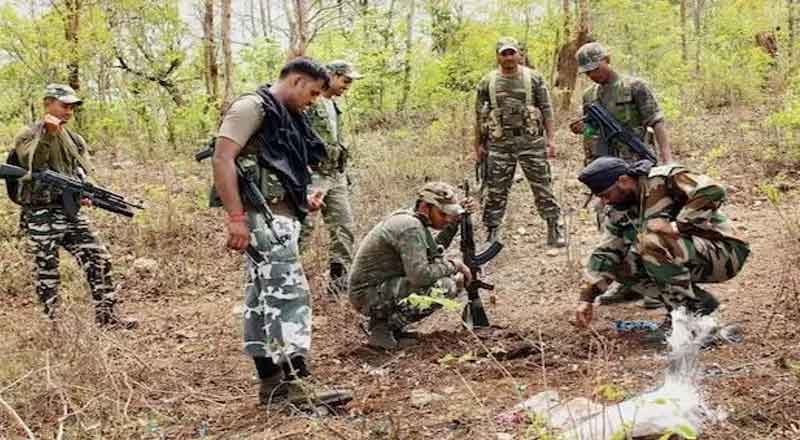A Strategic Push by Central Government
The Naxal insurgency, often referred to as Left Wing Extremism (LWE), has long been one of India’s most persistent internal security threats. Particularly concentrated in the central and eastern regions of the country, this insurgency has led to decades of violence, disrupting lives and development in the affected regions. To counter this, the central government, in collaboration with state governments, has implemented a series of Naxal eradication programmes over the past several years. These efforts have ranged from military operations to socio-economic initiatives aimed at tackling the root causes of the insurgency, such as poverty, lack of infrastructure, and land-related issues.
One of the key strategies in this fight has been the aggressive operations launched by security forces in regions like Chhattisgarh, which has historically been a Naxal stronghold. In 2024 alone, there have been numerous successful operations that have significantly dented the Naxal ranks. This narrative explores the recent successes in this prolonged battle and the government’s commitment to eliminating Naxalism.
28 Naxalites Killed in Bastar
On Friday, a major victory was achieved in the Bastar region of Chhattisgarh when security personnel killed 28 Naxalites in one of the biggest operations against Maoists this year. The encounter, which took place in the dense forests along the Narayanpur-Dantewada border, is being hailed as a major breakthrough in the ongoing efforts to dismantle Naxal strongholds in the region.
According to senior police officials, the joint operation involved personnel from the state police’s District Reserve Guard (DRG) and Special Task Force (STF). The gunfight began around 1 PM near the villages of Thulthuli and Nendur in Abhujmaad, a known Naxal-dominated area. After intense fighting, 28 Naxalites were gunned down, and a significant cache of weapons, including an AK-47 rifle and a Self-Loading Rifle (SLR), was recovered from the site.
Dantewada Superintendent of Police Gaurav Rai, who had initially estimated the death toll to be around 30, stated that the encounter is part of a series of proactive measures being taken to root out the Maoist presence in the Bastar region.
Government’s Commitment to Eliminate Naxalism
Following the successful operation, Chief Minister of Chhattisgarh, Vishnu Deo Sai, praised the security forces for their bravery and effective execution. In a post on X (formerly Twitter), CM Sai emphasized the determination of the ‘double engine’ government—referring to the BJP-led governments at both the state and central levels—to completely eradicate Naxalism from Chhattisgarh.
“There is news of 28 Naxalites gunned down in an encounter with security forces in the border area of Narayanpur-Dantewada districts. The great success achieved by the soldiers is commendable. I salute their courage and valour,” Sai wrote. He further reiterated that the government’s fight to eliminate Naxalism will continue until it reaches its conclusion, with the complete restoration of peace and order in the affected areas as the ultimate goal.
Ongoing Successes: 185 Maoists Eliminated in 2024
This latest encounter adds to the growing tally of successful anti-Naxal operations in Chhattisgarh this year. With 185 Maoists already killed in various operations across the Bastar region in 2024, the state is witnessing significant progress in its efforts to weaken the Maoist insurgency. The Bastar region, which includes seven districts such as Dantewada and Narayanpur, has been a focal point of the Naxal conflict for decades. However, the increasing frequency of successful operations suggests that security forces are gaining an upper hand.
Earlier this year, in April, another major operation in the Kanker district resulted in the deaths of 29 Naxalites, including several high-ranking cadres. These operations are not only depleting the insurgents’ ranks but also sending a strong message that the state will no longer tolerate Naxal activities.
India’s Goal to Be Naxal-Free by 2026
Union Home Minister Amit Shah, during a visit to Chhattisgarh in August 2024, reaffirmed the government’s commitment to eliminating Left Wing Extremism from the country. He set a target for India to be free from Naxalism by March 2026, emphasizing that a strong, uncompromising strategy was necessary to achieve this objective. Shah highlighted that while significant progress has been made, the final assault on Naxalism requires a combination of military, intelligence, and socio-economic interventions.
The central government’s approach has not been limited to combat operations alone. Various development programmes, including the construction of roads, schools, and healthcare facilities, have been launched in Naxal-affected regions to address the long-standing grievances of local communities. These initiatives aim to integrate these regions into the mainstream economy and provide alternative livelihoods to those vulnerable to Naxal influence.
A Comprehensive Approach to End Naxalism
The central and state governments’ multi-pronged approach to dealing with Naxalism, involving both military action and development initiatives, is showing tangible results. The successful operation in Bastar, where 28 Naxalites were killed, is a significant milestone in this ongoing battle. As security forces continue to make headway in reclaiming Naxal-affected regions, and with the government’s commitment to eradicating Naxalism by 2026, there is growing optimism that peace and stability can be restored to these areas. The determination of both the government and security forces, coupled with the socio-economic upliftment of affected regions, is central to achieving this goal.
(With inputs from agencies)





